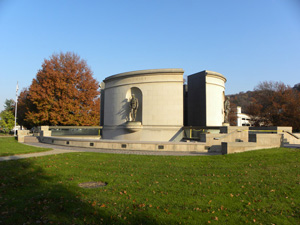

Remember...
Waldo Ray Williamson
1920-1942
"The USS Edsall has not received the credit due. It was the first U.S. vessel to sink a capital ship of the IJN [a submarine of the Imperial Japanese Navy]."
Bruce A. Williamson
 |
Remember...Waldo Ray Williamson
|
On Sunday, May 24, 2015, the Charleston (West Virginia) Gazette-Mail carried the poignant story of a Purple Heart found in a box of trinkets bought at an auction. The engraving on the back of the medal indicated that it had been issued to Waldo R. Williamson, QM3c, USN. Purchaser Sally Jarrett believed that Quartermaster Williamson was from Lincoln County but had no other clues to go on. Still, she was determined to find the rightful owner. To this end, staff writer Rusty Marks chronicled the story for the Charleston newspaper. ("Missing in Action: Woman Seeks Rightful Heirs of Purple Heart": 1B, 3B.)
Within a week, the Purple Heart was in the hands of Waldo's sister, Jeanette Wright. Fittingly, Mrs. Wright was identified the week of Memorial Day. She said the medal had been missing since 1972 and was amazed that it found its way back to her after more than 40 years. Marks' follow-up Gazette-Mail article says, "That's the year Wright left her Lincoln County homeplace near Yawkey and moved to Charleston. When she went back later to retrieve the medal and other items, the Purple Heart was gone." ("Stolen Purple Heart Completes 40-Year Journey Back Home," Charleston Gazette-Mail, 31 May 2015: 1A, 11A.)
According to the 1930 U.S. Federal Census, U.S. Navy Quartermaster Third Class Waldo Ray Williamson was born in Texas. Jeanette Wright says he was possibly born in Austin, but she isn't sure of the city. However, she is sure of the date; he was born on June 17, 1920, the son of Andrew Jackson Williamson and Suda Nancy Griffith Williamson. Originally from Ritchie County but now relocated to Lincoln County, Andrew Jackson was a roustabout on oil rigs and spent some time in Oklahoma and Texas during a period of rapid growth in the oil industry, where his skills were very much in demand. Although Waldo was born in Texas, the family soon moved back to West Virginia.
In addition to Jeanette, who was ten years younger than Waldo, his siblings were Max Griffith Williamson (one year younger) and Alvin J. Williamson (about nine years younger). All the Williamsons graduated from Duval High School, a proud accomplishment at the time. But Mrs. Wright notes that two of her brothers (Waldo and Max) joined the Navy as soon as they were 18, recalling that in the late 1930s there wasn't much else for a young man from Lincoln County to do but enter the service. It is worth noting that the brothers enlisted well before the attack on Pearl Harbor. (Nephew Bruce Williamson said that Alvin would join the U.S. Army instead; Alvin served during the Korean War.) Jeanette speaks today with quick remembrance of her brother. She recalls him as being "very sweet, easy going, and soft spoken." By contrast, she remembers Max as being the more outspoken of the one-year-apart brothers.
When the Japanese attacked Pearl Harbor 7 December 1941 Edsall readied for action with DesDiv 57 at the southeast Borneo oil port of Balikpapan. She raced to Singapore, embarked a British liaison officer and four men to search for survivors of HMS Prince of Wales and HMS Repulse, sunk off Malaya the 10th. She intercepted a Japanese fishing trawler with four small boats in tow and escorted them into Singapore. She joined Houston (CA-30) at Surabaya to escort shipping retiring to the relative safety of Darwin, Australia. While so serving, she became the first U.S. destroyer to sink a full-sized enemy submarine in World War II. With three Australian corvettes, Edsall sent I-124 to the bottom on 20 January 1942 off Darwin.Continuing to escort convoys in a race against time, Edsall was damaged when one of her own depth charges exploded prematurely during an antisubmarine attack 19 February 1942. She gamely continued to operate off Java, then on 26 February steamed from Tjilatjap to rendezvous with Langley (AV-3). The 27th, the seaplane tender and escorts Edsall and Whipple (DD-217) were attacked by nine large twin-engine bombers which damaged the historic Langley so badly she had to be abandoned. Edsall picked up 177 survivors, Whipple 308. On the 28th the two destroyers rendezvoused with Pecos (AO-6) off Flying Fish Cove, Christmas Island. More Japanese bombers forced Edsall to leave before transferring all Langley men, but she completed the job on 1 March, then headed back to Tjilatjap. She never arrived. The gallant old four-piper fought a hopeless action against Japanese battleships Hiei and Kirishima, who sank her on the afternoon of 1 March 1942.
Edsall received two battle stars for World War II service.
Family information provided by Waldo Ray Williamson's sister Jeanette Williamson Wright and nephew Bruce A. Williamson.
Article prepared by Patricia Richards McClure
August 2015

West Virginia Archives and History welcomes any additional information that can be provided about these veterans, including photographs, family names, letters and other relevant personal history.